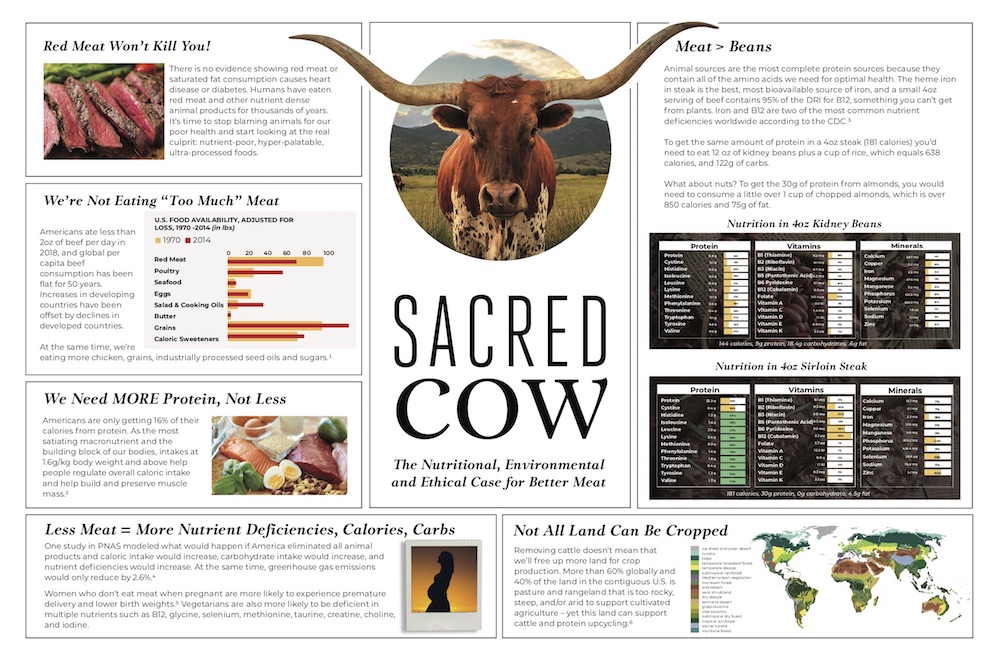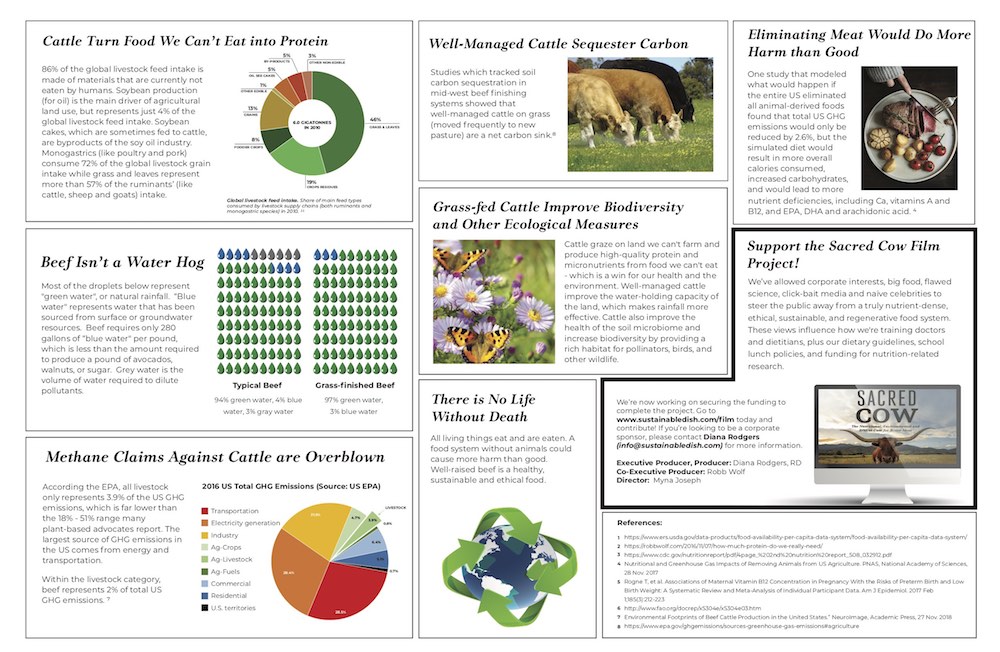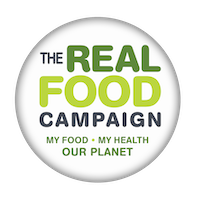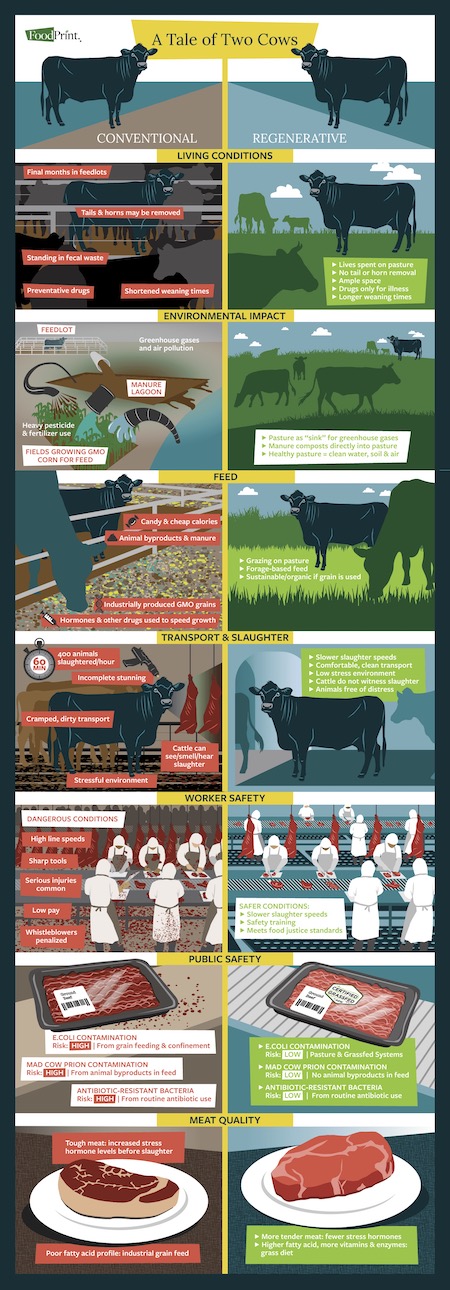Overview
We have been told for many years to cut down on red and processed meat for health reasons; however, the evidence for this is weak and new guidance was suggested in Oct 2019.
2019 was also the year of a significant movement towards a plant-based starting with Veganuary and then with the publication of the EAT-Lancet Planetary Health Diet. We are being told to cut right down on our meat intake on the basis that cows (and other ruminants) significantly contribute to climate change. However, this claim too has largely been disproven. In fact, switching to a more plant-based diet is likely to worsen the situation with further soil degradation and release of carbon into the atmosphere from intensive arable production.
Meat has played a central role in our diet for millennia and a diet low in animal products often fails to deliver key nutrients.
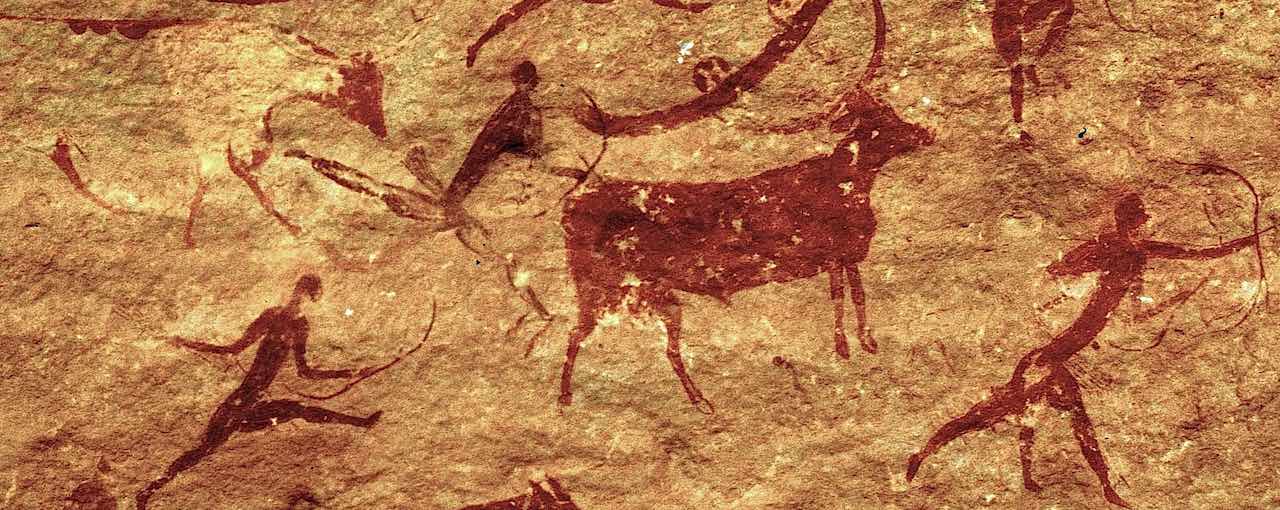
Whatever your choice and dietary preferences around meat, we want strongly to make the case for BETTER meat (and plenty of veggies).
Below we explore in more detail the role of meat for health. We also look at sustainability, ethical and affordability issues.
Meat & Health
Animal foods provide us with some of the most nutrient-dense foods on the planet – foods that have been eaten by our ancestors since the dawn of Homo sapiens some 200,000 years ago.
We humans have evolved the anatomy of omnivores (eating both plant and animal foods), indeed some would say that eating meat is what made us human – allowing our brains to grow while our digestive systems shrank. However, the ratio of meat to plants has varied across populations, reflecting the availability of these foods. Our ability to get the nutrition we need from a diet low in meat will vary with our genetics and will be influenced by what our ancestors ate. Undoubtedly too, we will discover that our gut microbiome plays a key role in our ability to make the most of our food.
Quality vs Quantity
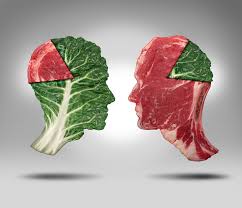 In a mixed omnivore diet, we believe the quality of the food we eat – both plant and animal – is more important than the quantity.
In a mixed omnivore diet, we believe the quality of the food we eat – both plant and animal – is more important than the quantity.
But what proportion of our plates should be meat for optimum nutrition and health? There is no simple one-size-fits-all answer to this question and as alluded to above, individual needs will depend in part on genetics.
This helpful blog by Dr Sarah Ballantyne, PhD explores the issue of quantity: How Much Meat versus Veggies? September 2015
More on meat quality coming soon…
Red meat
There are different definitions for red meat but most often we would think of beef, lamb, and pork. However, for health and sustainability reasons, it may be helpful to consider beef and lamb (and meat from other ruminants) separately from pork.
The quality, safety and nutritional profile of the meat we eat will depend upon what that animal has eaten in the course of its life. Animals should eat a varied and natural diet, free from added chemicals. For ruminants, this natural diet is made up of a diversity of grasses and other plants that grow in and around pasture land. However, these important factors are rarely taken into consideration in nutrition studies, leading to confusing messages.
Here is an editorial which suggest earlier messages to cut down may have been wrong:
- Meat Consumption and Health: Food for Thought Editorial, Annals of Internal Medicine, Oct 2019
There is so much debate about meat that the topic has generated a plethora of possible links to share. We hope the ones we have selected are helpful:
- Guide to red meat – is it healthy? – Diet Doctor, updated September 23, 2022
- Meat and mental health: a systematic review of meat abstention and depression, anxiety, and related phenomena. Crit Rev Food Sci Nutr. 2021
- Animal-sourced foods for improved cognitive development Anim Front. 2019 Oct
- Red Meat: It Does a Body Good! by Chris Kresser updated Aug 2018
We believe that red meat from pasture fed ruminants is a healthy part of an omnivorous diet, and is healthier than other types of meat. We would also advocate eating nose-to-tail – more on this to come.
Animal Fats
The debate over whether animal fats help or harm our health has been at the centre of contentious debate for some years.
We will examine these arguments in due course in: Fats and Oils
Meat & Sustainability
It’s not the COW it’s the HOW
Cows and other ruminant animals are currently taking a lot of blame for climate change, due to the methane emitted in their ‘burps’… but is it the cow or the how?
This topic featured strongly in the EAT-Lancet Commission Summary Report published in Jan 2019. The report recommended dramatic reductions in animal foods; however, many senior scientists have detailed strong criticisms of the report, from both an environmental and health perspective. From our Real Food Issue: Eat-Lancet – is there such a thing as ‘one-size-fits-all’ sustainability?
In The “eat less meat” movement is growing. Does it distort science? Lynne Curry explores “Why ranches, cattle, and meat-eating may play a role in fighting climate change” published September 2019 in The New Food Economy
For more on this topic visit:
- Our Sustainability section
- The Sustainable Food Trust website.
Meat & Ethics
We care deeply about the welfare of animals raised for food. We also care about the loss of animal species and the harm that comes from intensive crop farming. When considering ethics it is not enough to simply switch to a plant-based diet.
In Eating Animals Isn’t the Problem, Sam Garwin discusses the “fundamental brokenness of our relationship to animals and the planet” and ‘meat alternatives’ – Heated, Sept 2019
Ethical meat and dairy
We feel choosing high welfare meat is extremely important. To do this you need to trust your supplier or if buying from the supermarket you need to understand the labels: understanding the labels
Ask your local butcher where their meat comes from and if possible visit the farms yourself.
There are many organisations now selling direct to the public which have ethical and sustainable credentials – here are just a couple to give you an idea of what to look for. Ideally, find a local supplier who you can form a relationship with.
The Tale of Two Cows – The FoodPrint of Beef
Is adopting a plant-based diet the answer to reducing animal suffering and death?
For some people this could be the right approach ethically, however eating a vegetarian or vegan diet doesn’t automatically mean no animals were harmed, it is still really important to know where your food came from.
Here is an article which highlights the harms of industrial agriculture on wildlife: Ordering the vegetarian meal? There’s more animal blood on your hands – published in Insight 2011, updated Apr 2019
Mike Archer argues that:
“going vegetarian, or even vegan, to minimise animal suffering and promote sustainable agriculture, actually kills more sentient animals living in vegetable crops than livestock farmed in paddocks”
Figures, published in 2011, suggest that in Australia, producing wheat and other grains industrially may results in:
- at least 25 times more sentient animals being killed per kilogram of useable protein
- more environmental damage, and
- a great deal more animal cruelty than does farming red meat
Meat & Affordability
We want you to eat only good quality meat from ethically raised pasture-fed animals. But is this possible on a budget?
We say yes it is – if we look beyond the ‘standard’ cuts of meat. We believe affordability means eating nose-to-tail, choosing to cook traditional, nutrient-dense much less expensive cheaper cuts of meat and offal… which will not only nourish us, but will help us to reduce food waste.
- Nose-to-Tail Eating: Everything You Need to Know by Chris Kresser June 2019
- In praise of bones and fat by Joanna Blythman, BBC Good Food
For more on this topic visit:
Our Food Affordability page
The Bottom Line…
We think that good quality meat, particularly regeneratively raised and pasture-fed beef and lamb, can be both healthy and sustainable.
We think the film (& book) Sacred Cow, the case for better meat from the creators of the poster below from Sustainable Dish really neatly summarises some of the issues around eating meat.
